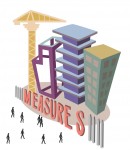You would be hard-pressed to find a single UCLA student who doesn’t feel that their rent is too high.
It’s no secret that renting in Los Angeles is ridiculously expensive, with the median rent for a two-bedroom apartment currently sitting at around $3,000. In Westwood, that number goes up to $4,200. Combine this fact with the growing income and wealth inequality in America that we’ve been hearing so much about, and there’s clearly a dire state of affairs.
Despite this, Measure S, a measure which would have had the inevitable result of further raising rents, sneaked onto the March 7, 2017, Los Angeles municipal election ballot.
Measure S consisted of a two-year moratorium on any construction that would increase development density. It would have also prohibited any new development that didn’t meet certain community guidelines – guidelines that would be reviewed every five years.
Before the vote, the measure had already garnered the opposition of 18 UCLA professors, and was arguably – especially from from a student’s perspective – the most important issue Bruins voted on this year.
Angelenos need to ensure mistaken and misleading measures such as Measure S do not appear on city ballots in the future.
The city simply can’t afford these kinds of fights over development because it currently faces a dire housing shortage. Tim Kawahara, the executive director of the UCLA Ziman Center for Real Estate, said that any measure that limits the production of new supply will in theory drive rents higher. Students and recent graduates, along with the other 54 percent of Angelenos who rent housing, would be burdened with higher housing costs.
While the UCLA campus itself would not have been subject to Measure S because it lies on state-owned land, it would still have affected the UCLA community. The vast majority of students leave on-campus housing by their third years and usually move into the Westwood area, where Measure S would have had a disastrous effect on rental prices.
This directly contradicts the Measure S campaign claim that housing would become more affordable. The campaign was repeatedly dishonest, claiming that certain prominent opponents in fact supported it and misleading the public on the economic impact the measure would have had.
The real reason the city’s rents are so high is because of land-use restrictions – like the ones Measure S would have imposed. These kinds of restrictions, generally known as downzoning, assign land to a zoning grade under which the permitted density of housing and development is reduced. In a nearly 700 page dissertation from 2013, UCLA graduate student Greg Morrow outlines how in 1960, Los Angeles had a population of 2.5 million and a zoning capacity of 10 million. By 2010 the population had risen to 4 million citizens while the zoning capacity had decreased to only 4.3 million because of downzoning.
The Los Angeles City Council has been handing out project-specific amendments to the general plan to work around these increasingly restrictive zoning laws, instead of rethinking the general plan as a whole. One theory behind Measure S is that stopping general plan amendments and zoning amendments and pausing development for two years would have forced the council to do the revamping it hasn’t been doing.
It’s obvious that this theory isn’t the least bit pragmatic or efficient.
“There are 88 cities in the LA county,” said UCLA adjunct professor Jerry Nickelsburg. “Measure S (would have pushed) development into the other cities and to parts of the city where zoning restrictions are still far from having been met.”
This means recent grads looking to work in LA would have been forced into parts of the city where zoning capacities haven’t yet been met, or even into other cities in the county where Measure S wouldn’t apply.
Another major selling point the Measure S campaign put forth was that it would have been be a solution for improving traffic in LA. The measure included parking requirements for new developments to ensure that as many parking spots as possible would have been available. However, parking increases a neighborhood’s capacity to store cars, not move them. As CityLab puts it, if you bring parking, people bring cars, increasing traffic. Furthermore, big development will move outside LA to other parts of the county, making commuting a nightmare. The only way traffic will truly improve is if city officials work on increasing access to public transportation, not restricting development.
In the face of overwhelming evidence contradicting the misinformation campaign waged by Measure S, it is imperative that similar measures do not resurface in the future.
This fight between homeowners, developers and renters has been going on for decades, but homeowners need to understand that attempting to control the housing market through these propositions ends up hurting the overall economy of the city. According to Beacon Economics, which was paid for by opponents of Measure S, a two-year development moratorium would cost the city $3.8 billion in economic output, more than 24,000 jobs and nearly $1.3 billion in wages.
As the future of the city, it is up to students to stand up for the needs of LA’s renter population and ensure that the slow-growth movement ends once and for all with Measure S.
